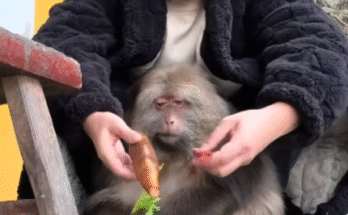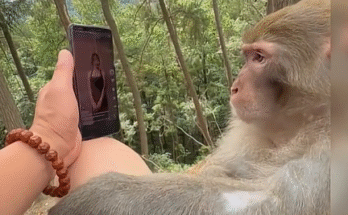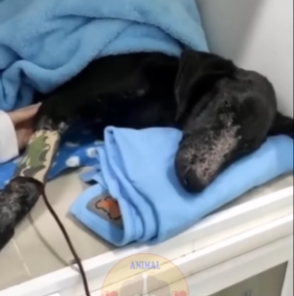
It was a rainy afternoon when I heard the first faint whimpers coming from behind a pile of garbage near the alleyway. The sky was heavy, the wind was sharp, and the streets were nearly empty. Most people would have ignored it, assuming it was just the city noises or stray cats fighting over scraps. But something in that sound stopped me mid-step. It was soft, almost desperate, yet oddly persistent — a tiny cry that seemed to whisper, “Please… help me.”
I carefully stepped closer, pushing aside soggy boxes and discarded food containers. My heart sank when I saw it: a small, trembling puppy, stuffed inside a black trash bag. Only a tiny opening revealed his wet, dirty face and one trembling paw. He had been left to die. I could see the faint movement of his tail, flicking weakly, as if he hadn’t given up even in the face of certain death.
The puppy’s eyes were wide, filled with fear and confusion. He tried to move, to crawl out of the bag, but the garbage and the plastic held him tightly. Each whimper seemed to pierce the rain-filled alleyway like a silent plea for life. My chest tightened, and without a second thought, I rushed to untangle him from his plastic prison.
Gently, I lifted the edge of the bag and reached in. His tiny paws scratched at my fingers, not in aggression, but in desperation to escape. The smell was overwhelming — a mix of garbage, wet fur, and fear. But even in that horrifying situation, his tail still moved. That small, wagging motion filled me with awe and heartbreak at the same time. Hope, it seemed, had refused to leave him.
After a few tense minutes, I managed to free him completely. He collapsed in my arms, shivering violently. His body was soaked, his fur caked with mud and grime, and his ribs pressed against the thin skin of his tiny frame. He was weak, malnourished, and scared beyond measure. I wrapped him in my jacket, holding him close to my chest, and whispered softly, “It’s okay, little one. You’re safe now.”
The drive home was quiet, save for his faint whimpers. I kept the jacket around him, offering warmth and comfort. Every so often, he would nuzzle my hand, almost as if to say, “Thank you for noticing me.” It was a fragile trust, but it was there. Even in the harshest conditions, even after being left in a trash bag to die, he had chosen life.
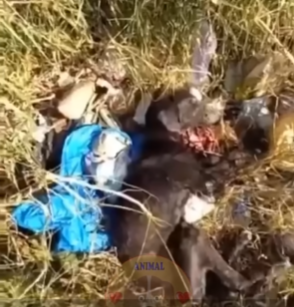
When we arrived home, I gently placed him on a soft blanket in a quiet corner. He immediately curled up, exhausted but alert. His eyes tracked every movement I made, wary but trusting. I gave him a small bowl of water and some soft food. He ate slowly, carefully, as though he feared it might be taken away. Watching him eat, I couldn’t help but think of all the other puppies like him — abandoned, ignored, left to die in silence.
Over the next few days, the puppy — whom I named Chance — began to recover. His tail, once weak and trembling, grew stronger with every passing moment. Every wag, every excited twitch, was a testament to his resilience. It amazed me how, even after facing the worst, a small creature could still find the courage to live, to hope, to trust again.
Chance had scars, both visible and invisible. His fur was patchy from neglect, and his paws bore scratches from struggling inside the plastic bag. But his spirit was unbroken. He greeted every visitor with cautious curiosity, sniffing their hands before allowing any touch. His tail wagged nervously at first, then with growing confidence as he realized that kindness no longer hurt him.
One rainy afternoon, a neighbor’s child noticed him through the window. Her eyes lit up with excitement. “Mom! Look! The little dog!” she squeaked. Chance froze initially, unsure of this new human. But after a moment, he sniffed the air and wagged his tail, a small flick that said, “I can trust you.” The girl giggled and slowly extended her hand, letting him come to her. That tiny interaction was like a bridge being built — one small act of trust overcoming the trauma of abandonment.
Chance began to learn about life again. He played in the yard, chased falling leaves, and even learned to sit and beg for treats. Every small victory was a reminder of his strength. He had survived the unimaginable, and now he was learning to thrive. Every time his tail wagged, it felt like a heartbeat of resilience, proof that hope never truly dies, even in the darkest moments.

There were nights when I would wake to find him curled up beside me, eyes alert even as he slept. I could feel the tiny tremors of his body, remnants of the fear he had carried for so long. But his presence was also a constant reminder of survival, of the miracles that can happen when someone chooses to act rather than ignore.
Chance also began forming bonds with other dogs in the neighborhood. At first, he was timid, hiding behind me whenever a larger dog approached. But slowly, he learned to play, to chase, to explore. His tail, once a symbol of mere survival, became a banner of joy. Watching him interact with others, wagging vigorously, rolling in the grass, I realized that he had gone from a puppy left to die to a being fully embracing life again.
Sometimes, I would think back to that rainy alley — the black trash bag, the cold air, the muffled cries. It was almost unbearable to remember. But it also strengthened my commitment to helping animals in need. Every small act of kindness can change a life completely. Chance’s survival wasn’t just luck; it was a combination of his innate resilience and the choice of a human to notice, to act, to care.
Months passed, and Chance’s transformation was remarkable. His fur grew soft and shiny, his body plump and healthy, and his eyes sparkled with mischief and intelligence. He became the heart of our household, a living reminder that even in the direst circumstances, life persists. He loved unconditionally, played joyfully, and slept peacefully, no longer haunted by the trauma of abandonment.
I often take him back to the alley where I found him, though the trash bag is long gone. Chance sniffs around curiously, tail wagging, as if to mark the place where he had faced the abyss and chosen life. It’s a quiet ritual, a moment to reflect on how far he’s come. His journey from despair to hope is etched in every wag, every playful bark, every affectionate nuzzle.
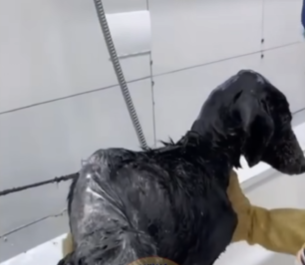
Chance’s story has inspired others as well. Neighbors, friends, and even strangers have come forward, sharing their own tales of rescuing animals or helping strays. It’s become a small community effort — picking up trash, leaving out water and food, and creating safe spaces for animals that society often ignores. One tiny puppy, left to die, became a catalyst for compassion, teaching everyone that hope never truly dies.
Every time I look at him, tail wagging energetically as he runs across the yard, I am reminded of that day in the rain. That small, trembling movement, that flick of his tail in the trash bag, was a silent declaration: I am not done yet. I will survive. I will hope. And survive he did, thriving beyond anyone’s imagination.
Chance taught me the power of noticing, the importance of action, and the incredible resilience of life. He reminded me that even when all seems lost, hope lingers — sometimes in the smallest flick of a tail, sometimes in the softest whimper, waiting for someone to hear it.
And now, every day, when Chance greets me at the door with joy in his eyes and his tail wagging like a banner of life, I am reminded of a truth that he proved in the most heartbreaking and miraculous way: no matter how dark the night, no matter how cruel the world may seem, hope never truly dies. 🌟🐾
